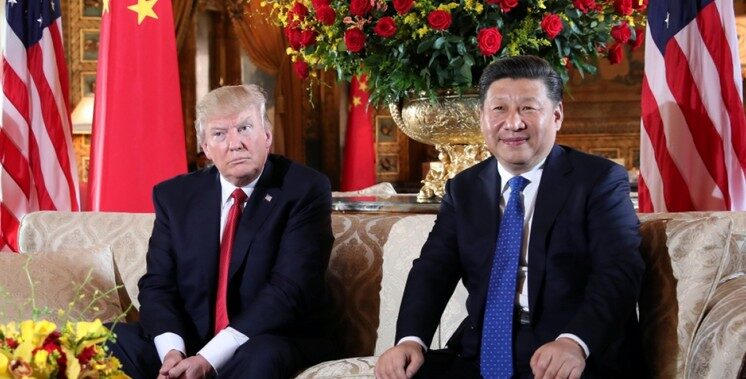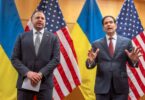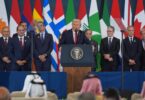The October 30 in-person meeting between Chinese President Xi Jinping and US President Donald Trump in Busan (South Korea) attracted global attention. Trump said it was “12 out of ten” after the meeting. However, his contrasting bombast was noticeable in claiming Xi assured him Beijing will not attempt to unify Taiwan while he is POTUS, but admitting separately the Taiwan issue never came up in the meeting. When asked about China buying Russian oil, he said this also didn’t figure in the meeting. Xi was more composed in the meeting that largely focused on US-China trade tensions. Financial Times headlined ‘China emerges as a peer-rival’ to the US, while Associated Press said Trump gained little from the meeting. Trump looked forward to visiting China early next year and invited President Xi to visit the United States.
White House described the Trump-Xi meeting as: a massive victory safeguarding US economic strength and national security while putting American workers, farmers, and families first; China to end flow of fentanyl precursors to US, export controls on Rare Earth Elements (REEs) and Chinese retaliation against US semiconductor manufacturers/other US firms; Chinese markets to open for US soybeans/other agricultural exports. America will lower tariffs on Chinese imports imposed to curb fentanyl flows and maintain suspension of heightened reciprocal tariffs on Chinese imports until November 2026.
According to China’s official brief, Xi noted that China-US relations have remained stable, both should be partners and friends even though it is normal for the two leading economies to have friction sometimes. Trump told XI, “I am ready to continue working with you to build a solid foundation for China-US relations and create a sound atmosphere for the development of both countries.” Xi emphasized good momentum in China’s economic development, which grew 5.2% in first three quarters of 2025. Xi noted China-US business relationship should continue to serve as the anchor and driving force for bilateral relations, stressing dialogue is better than confrontation. He pointed out the potential for cooperating in combating illegal immigration and telecom fraud, anti-money laundering, artificial intelligence, and responding to infectious diseases. Both presidents agreed to maintain regular interactions. Trump looked forward to visiting China early next year and invited Xi to visit the US.
Trump’s main headache is REEs; US Treasury Secretary Scott Bessent says China “made a real mistake” by threatening to restrict exports of REEs which has jolted the US and allies to secure new sources within the next two years. Trump has so far signed REE deals with Australia, Canada, Cambodia, Japan, Malaysia, Pakistan, Thailand and Ukraine to break China’s monopoly. But it depends on the grade of the deposits; mining becomes uneconomic if the REE grade and quality of the deposits is not high enough. Same goes for the US-Pakistan deal for estimated US$6 trillion REE reserves in the highly restive Balochistan region.

China controls nearly 70% of REE mining, 90% of global REE processing and 98% of global REE magnet production. Being in the REE business for over four decades, China has been flooding countries with excess supply to push very low prices, making mining in other countries unviable. China holds 44 million MT of REEs compared to America’s 1.9 million MT. Four of the top five founding members of BRICS collectively hold 75.7 MT of REEs, with India holding 6.9 million MT in third place behind China’s 44 million MT and Brazil 21 million MT; albeit the economic viability of mining these deposits is yet to be established. It wouldn’t be surprising if Trump’s tough stance on India is because he eyes an REE deal with India as well. America’s US$2 billion in REE mining and processing projects in Australia (world’s fourth largest REE producer) targets almost US$53 billion in REE deposits. Australia hosts 89 active REE projects compared to Canada’s 18, Brazil’s 13 and America’s 12.
With regard to semiconductors, Trump said in an interview with CBS he won’t allow China access to Nvidia’s most advanced ‘Blackwell’ chips, as giving China advanced chips will provide it with ‘an equal advantage’ in the competition, while claiming that the US is winning the AI race. Earlier after the October 30 bilateral meeting with Xi, Trump had told reporters semiconductors were discussed and China would be talking to Nvidia/ others for procuring chips. Concurrently, Chinese scientists claim to have created a superfast analogue chip that can solve complex maths problems for advanced scientific tasks and AI while using less power than conventional computing. It can reportedly perform calculations at a processing rate 1,000 times faster than digital processors like Nvidia’s H100 graphics processing unit (GPU). The device has reportedly achieved accuracy comparable to digital systems, which could help address computing challenges for AI and 6G communications. It’s detection of wireless communications rivalled that of digital processors.
China has announced that the digital RMB (Renminbi, Chinese Yuan) cross-border settlement system will be fully connected to the ten ASEAN countries and six Middle Eastern countries. Implying 38% of the world's trade volume will bypass the SWIFT system with blockchain technology. Moreover, China has compressed the clearing speed to seven seconds as the transactions don’t go through intermediary banks, compared to 3-5 days required in cross-border payments in SWIFT, because of which the handling fee is drastically reduced. China is using blockchain technology to increase trade efficiency by 400% and the technology makes transactions traceable and automatically enforces anti-money laundering rules. 87% of countries in the world have already completed adaptation of the digital RMB system, and the scale of cross-border payments has exceeded US$1.2 trillion (https://www.akhilesh.info/the-digital-yuan-revolution-how-china-is-redefining-global-finance-and-challenging-dollar-dominance/). Will this de-De-dollarisation reset the world?
After meeting Xi in Busan, Trump posted on X, “My G2 meeting with President Xi of China was a graet one for both our countries. This meeting will lead to everlasting peace and success. God bless both China and the USA!” US War Secretary Pete Hegseth agreed that the US-China relationship “has never been better” and he had an “equally positive” meeting with China’s Minister of National Defence Admiral Dong Jun. These statements signal a complete U-Turn in America’s policy towards China. In May 2025, Michael Ellis, CIA’s deputy director had said, “China is an existential threat to US security in a way that we have never confronted before.”
The reason for this turnaround is the economic and diplomatic setback Trump faced after his tariff war on China. The Xi-Trump meeting is seen as Trump kneeling down to China (https://www.facebook.com/reel/2687221824781878). US national debt has crossed US$38 trillion and Trump’s tariffs have wiped off US$2 trillion US stocks (https://www.facebook.com/story.php?story_fbid=828809493441662&id=100089378572706&post_id=100089378572706_828809493441662&rdid=MIsOl8g8fqddfZxD#).
Geopolitics are moving fast. Tajikistan ending India’s nearly two-decade operational presence at its strategically vital Ayni Air Base due to Russian and Chinese pressure despite good Indo-Russian relations, indicates India’s foreign policy failure (https://defencesecurityasia.com/en/tajikistan-expels-india-ayni-air-base-russia-china-central-asia/) India faces urgent need to restructure its Central Asia strategy. According to Atul Singh, founder and CEO of Fair Observer, India must address systemic failures because of its over dependence on its diplomats and bureaucrats.
In Pakistan, the Shehbaz Sharif government is working on the 27th amendment to the Constitution to weaken Article 243 of the Constitution, giving extended tenure to Asim Munir (who otherwise retires on November 28 this year) and constitutionalize Field Marshal rank given to him in May 2025, Significantly, the proposed amendment will create a ‘Constitutional Court’ separate from the ‘Supreme Court’, giving extraordinary powers to Asim Munir, not that army has not always ruled Pakistan irrespective of whichever civilian government is in power.
Junaid S. Ahmad, Director, Centre for Study of Islam and Decolonization, Islamabad (Pakistan) says the Pakistan army is an army of mercenaries, Pakistani generals are masters are only masters of housing schemes, Swiss bank accounts, and the fine art of losing wars to India; their only successful operation against Palestinians was in Jordan, when they killed them. Pakistan’s generals are for rent, and the relationship of Gulf monarchs is transactional - Gulf supplies money/oil and Pakistan supply troops. They have graduated from slaves to indentured servants. Their loyalty is to whoever signs their checks in Riyadh, Abu Dhabi, or Washington.
Photographs of Shehbaz Sharif and Asim Munir presenting REE samples to Trump are viral on media and Taliban officials have asserted that Munir has been bypassing Sharif to foment trouble in Afghanistan. Trump is now talking about Pakistan talking about Pakistan conducting nuclear tests. This was reported in these columns earlier – suspected underground tests in the vicinity of Kirana Hills (Pakistan), Egyptian aircraft arriving with anti-radiation material, as well as US and Israeli aircraft landing in Pakistan – all of which would be already known to Trump. Pakistan recently said it had provided a base to a foreign country for deploying drones. During Taliban-Pakistan peace negotiations in Istanbul, Taliban have said that Pakistan has been using American drones to attack Kabul/Afghanistan.
In Bangladesh, Mohammad Yunus, Chief Advisor to the Interim Government and CIA’s blue-eyed recently presented a book with a map of Bangladesh with parts of northeast India to visiting Chairman of Pakistan’s Joint Chiefs of Staff Committee, General Sahir Shamshad Mirza. Yunus has now presented the coffee table book ‘Art of Triumph’ to a visiting Turkish delegation which included a Bangladesh map that includes India’s seven northeastern states, knowing that the US and China are covering his back. Admiral Naveed Ashraf, Pakistan's Navy Chief, is visiting Dhaka for four days starting November 8, indicating deepening Pakistan-Bangladesh ties.
While terrorist leader Abdul Rehman Makki continues his rant of Ghazwa-e-Hind (GEH) in Pakistan some 8,850 radical Islamist fighters are ready for GEH in Bangladesh. If that was not enough, the Al-Qaeda in the Sub-Continent (AQIS) has given a call for lone-wolf attack in India.
The US has nothing to say despite in all this. (https://www.sentinelassam.com/amp/story/more-news/national-news/al-qaeda-issues-lone-wolf-call-in-india-marking-alarming-tactical-shift).
The concept of G2 was prevalent during America’s Bush Administration, wherein, in addition to overt cooperation, periodic classified US-China meetings were also held on how to “handle” and “manage” developing countries that were of interest to both. This is what should concern India the most. Merely having a 10-year defence framework with the US and letting China annually benefit US$100 billion in bilateral trade may not suffice.
Finally, government would do well to heed Sushant Sareen calling G2 a lesson for India and saying: China has quietly built its strength and is now taking on the US but still calls itself developing country; India at best a middle power pretending to be a super-power: what is our grand op strategy if we become a super-power; keep quiet, stop boasting and build economic-military strength; stop asking for technology – state-of-the art tech; reform economy and governance; demolish bureaucratic stranglehold or get left behind.
G2 is a lesson for India. Here is China which has quietly built its strength and is now taking on the US which it has by its unmentionables. But the Chinese still say they are a developing country; and here are we who are at best a middle power pretending to be a super-power…
— sushant sareen (@sushantsareen) October 30, 2025
The author is an Indian Army veteran. Views expressed are personal.
More on related topics:
The United States–India 10-Year Defence Framework Agreement: https://www.thestrategicperspective.org/the-united-states-india-10-year-defence-framework-agreement/
India’s three new Joint Doctrines for Armed Forces: https://www.thestrategicperspective.org/indias-three-new-joint-doctrines-for-armed-forces/
Weaponizing Rare Earth Elements: https://www.thestrategicperspective.org/weaponizing-rare-earth-elements/
Hegseth Heralds Trump’s Wars: https://www.thestrategicperspective.org/hagseth-heralds-trumps-wars/
7 months of confusion – the even more perplexing US foreign policy: https://www.thestrategicperspective.org/7-months-of-confusion-the-even-more-perplexing-us-foreign-policy/
Great Game Myanmar: https://www.thestrategicperspective.org/great-game-myanmar/
Zangnan: between the Chinese Dragon and the Indian Lion: https://www.thestrategicperspective.org/zangnan-between-the-chinese-dragon-and-the-indian-lion/










